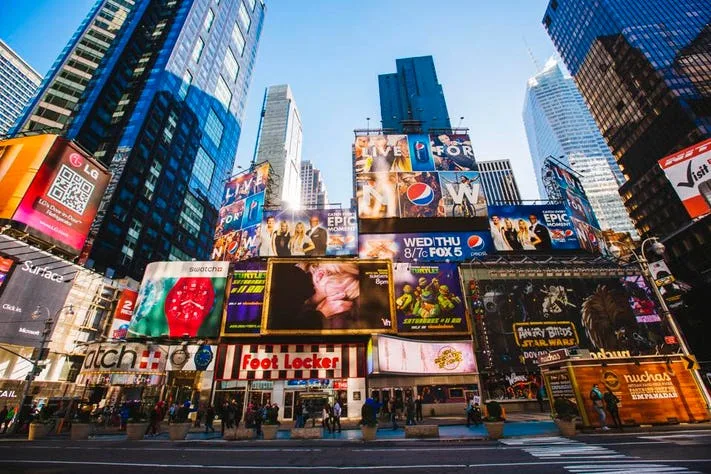Out-of-Home Advertising: Insights and Impacts

Out-of-home (OOH) advertising stands as a pivotal method in the marketing world, bridging the gap between traditional and digital media strategies. This form of advertising, designed to reach consumers while they are outside their homes, has evolved significantly over the years. From billboards and bus wraps to digital screens in elevators, OOH advertising encompasses a wide array of formats aiming to capture the attention of audiences in public spaces. Let’s delve into the essence of OOH advertising, its effectiveness, potential drawbacks, and some notable impacts it has had on companies.
What It Is and Why It Was Invented
OOH advertising was conceived from the necessity to reach a wider audience beyond the confines of their homes. In an era predating digital technology, it served as a means to captivate passersby and commuters with large-scale, memorable visuals. Its invention marked a significant leap in the advertising industry, allowing brands to establish a continuous presence in the everyday lives of potential customers. The rationale behind OOH advertising is not just visibility but the creation of impactful, lasting impressions that influence consumer behavior even when they are on the move.
This form of advertising harnesses the power of location and timing to maximize exposure. Whether it’s a billboard along a busy highway or a digital display in a bustling shopping center, OOH advertising strategically places ads where they are likely to be seen by a high volume of people. This ensures that messages reach a broad audience, including those who may not be easily targeted through traditional or digital media channels.
Examples of Successful Application of This Method of Advertising the Desired Product or Service
One of the most iconic examples of OOH advertising success is the “Got Milk?” campaign. Billboards featuring celebrities with milk mustaches not only captured attention but also sparked conversations, making it one of the most memorable campaigns of its time. Similarly, Coca-Cola has effectively utilized OOH advertising with its dynamic billboards in Times Square, showcasing interactive content that engages viewers and enhances brand recognition.
Another example is Spotify’s use of data-driven OOH ads that highlight quirky user habits and playlists, personalizing the experience and creating a sense of community among its users. These campaigns demonstrate how OOH advertising can be creatively leveraged to generate buzz, foster brand identity, and drive consumer engagement.
Apple’s “Shot on iPhone” campaign brilliantly showcases user-generated content on billboards across the globe. This strategy not only exhibits the high quality of the iPhone camera but also engages consumers by featuring real-life images taken by everyday iPhone users, thereby humanizing the brand and its products.
How Effective This Strategy Works
OOH advertising’s effectiveness lies in its ability to create wide-reaching impacts that extend beyond immediate conversions. It plays a crucial role in brand building by enhancing visibility and aiding recall, thereby establishing a stronger emotional connection with the audience. Studies have shown that OOH advertising can significantly increase foot traffic and online activity, illustrating its powerful influence on consumer behavior.
The integration of digital technology has further amplified the effectiveness of OOH advertising. Digital OOH (DOOH) allows for real-time content updates, audience targeting, and interactive experiences, making it an increasingly valuable tool for marketers. The ability to measure engagement and impact through digital integrations has provided advertisers with insights to refine and optimize their campaigns for better results.
Moreover, OOH advertising often serves as a complementary strategy that works in tandem with digital and social media marketing efforts. By creating a cohesive multi-channel campaign, brands can ensure a more robust and consistent message across different touchpoints, thereby enhancing the overall effectiveness of their marketing strategy.

What Are the Disadvantages of This Method
Despite its advantages, OOH advertising has its limitations. High costs associated with prime locations and the production of large-scale ads can make it an expensive endeavor, particularly for smaller businesses. Additionally, measuring the direct impact of OOH campaigns on sales and conversions poses challenges, making it difficult to calculate return on investment (ROI) with precision.
Another drawback is the potential for ad saturation in densely populated areas, where consumers may become desensitized to the barrage of advertisements. This can dilute the effectiveness of OOH campaigns, requiring advertisers to continually innovate and capture the audience’s attention in unique and engaging ways.
Examples of How This Strategy Has Harmed Companies
Not all OOH advertising campaigns hit their mark. Misjudged content or placement can lead to public backlash, as was the case with a famous beverage company’s billboard that was perceived as culturally insensitive. The negative reaction not only tarnished the brand’s image but also led to a costly withdrawal of the campaign.
In another instance, a tech giant faced criticism for an OOH campaign that overcrowded city landscapes with repetitive and intrusive advertising. The resulting public outcry highlighted the importance of striking a balance between visibility and community standards, underscoring the need for thoughtful consideration in OOH advertising strategies.
